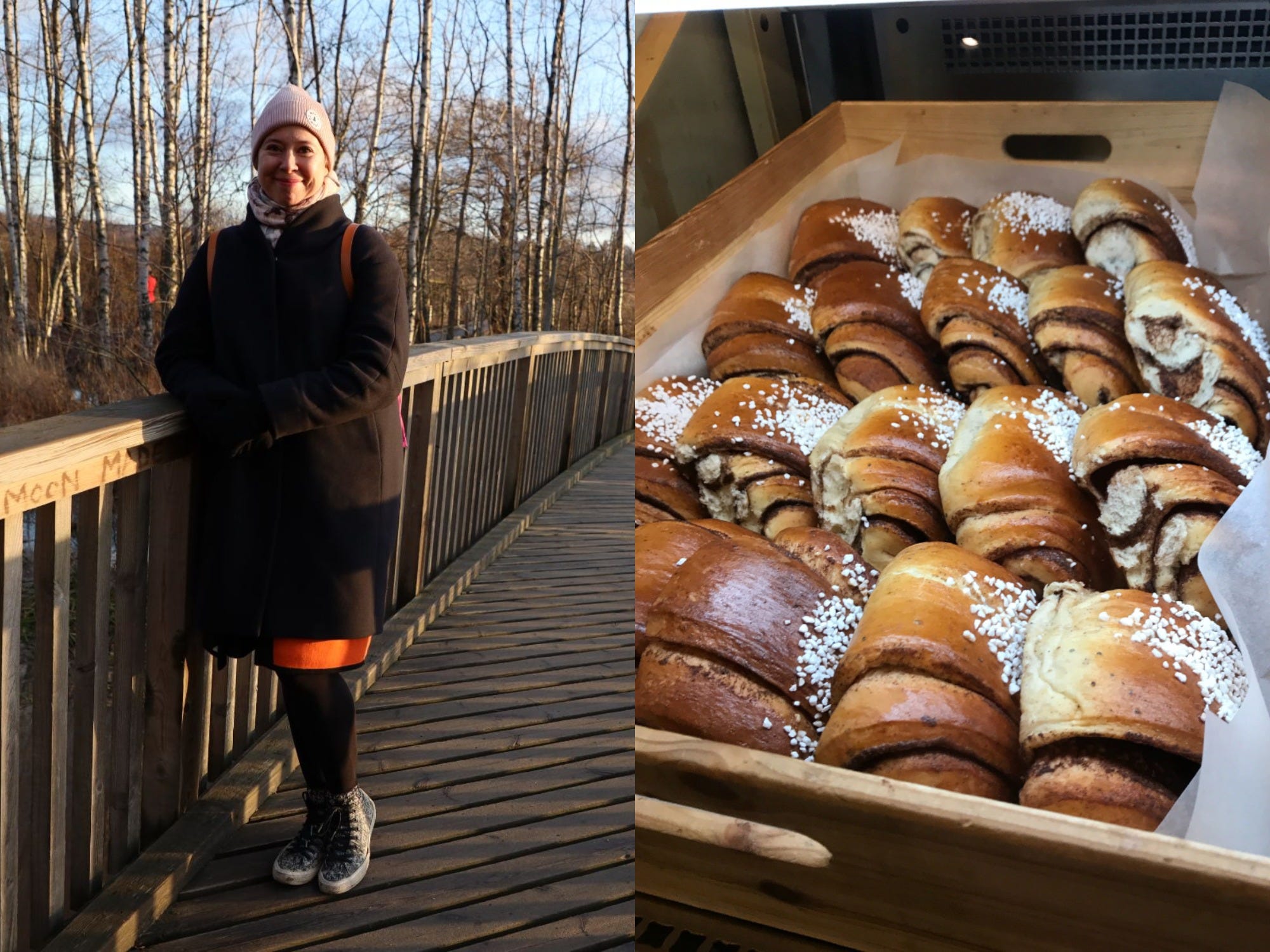- After being named the happiest country in the world for the second time, last summer Finland launched a “Rent a Finn” scheme for tourists.
- I missed out on the program during summer 2019, so decided to find my own happiness guide on a recent trip to Finland.
- And Finland has just been named the world’s happiest country for the third year running too.
- I spent the day with Helsinki local Heidi Johansson, who took me for a traditional Finnish lunch, on a long walk around a lake, then to her sauna – she told me most people have their own in their home.
- My day of living like a Finn taught me exactly why the lifestyle makes people so happy, from great work-life balance to spending time in nature.
- Visit Insider’s homepage for more stories.
Officially the happiest country in the world for the third year running according to the annual World Happiness Report, last summer, Finland launched a programme allowing tourists to “Rent a Finn” as a happiness guide.
Having failed to nab one of the coveted eight spots as part of the official scheme, I decided to rent a Finn of my own for a day when visiting Helsinki last month.
OK, I didn’t technically rent Heidi Johansson, who works for the Helsinki Tourism Office, but I did spend a day with the wonderful Finnish mother of two.
Heidi showed me around the capital city, taught me about Finnish values, and introduced me to many crucial aspects of the nation’s lifestyle, like spending time in nature and in saunas.
By the end of the day, I felt incredibly content - and it was finally clear why the Finns are the happiest people in the world.
Meet Heidi, a mother of two living on the outskirts of Helsinki, who spent a day showing me around Helsinki and teaching me about being Finnish.

The first place Heidi wanted to take me was one of the city's old market halls — there are three around the city, and this one, Vanha Kauppahalli, was right by where I was staying.

These are incredibly old buildings that now mainly contain international food stalls. There's a real sense of community, and Heidi told me many of the same people visit for a coffee and a chat every day, which I found pretty sweet.

We wandered into the city centre, past parks where children go sledding in winter and people have picnics in summer. Heidi explained that Helsinki grew a lot during the Art Nouveau period, so many of the buildings reflect that style.

The architecture in the heart of the city, particularly along the Esplanade, is stunning. I find ugly buildings can make me feel a bit blergh, and the opposite goes for beautiful ones. They're a joy to walk past.

We popped into a famous bakery, Cafe Esplanad, and picked up some traditional treats for later: cinnamon buns. Finnish bakeries serve lots of seasonal pastries, and they take cake very seriously: Heidi told me the debate over whether shrove buns should contain jam or marzipan divides the nation.

We soon ended up at the harbour, and although it was very chilly, it was lovely to be by the water and boats. There's something very calming about being by a large body of water.

There was a ferris wheel, but this isn't just any ferris wheel — one of the cabins is an actual sauna.

Unsurprisingly, it's the only one of its kind in the world.
http://instagr.am/p/Br-04EtFKiK
The ferris wheel is next to Allas Sea Pools, which, as the name suggests, is a selection of public pools, both heated and unheated.

Heidi said that in an ideal world, she'd swim there every morning, which struck me as a very wholesome way to start the day.

Despite it being mid-morning on a Monday, the pools were pretty busy. I'm not sure I'm brave enough to do lengths in the unheated pools in winter, but I loved the idea of the warm one.

Allas Sea Pools also has saunas, and they even put on yoga classes in one of them — like hot yoga, the idea is that the heat helps you relieve stress.

Source: Allas Sea Pools.
I was cold enough just from wandering outside, so we popped into a second market hall, the Old Market Hall, which has been around since 1889. They're real Finnish institutions.

Much like the first hall, it was charming, and people really seemed to value independent merchants.

We picked up a couple of these Karelian pies, a Finnish speciality, to add to our feast later in the day.

The market hall also has restaurants, such as Story. We sat down for some warming coffee and lunch: I had the traditional Finnish dish of Karelian hot pot made with boiled potatoes, gherkin, both beef and pork, and carrots. It was hearty, relatively healthy, and delicious.

Sufficiently warmed through, we set off again. I asked Heidi what working culture is typically like in Finland, and she told me work-life balance is genuinely very good, particularly if you work for an organization like the government.

Indeed, Finland's new 34-year-old prime minister Sanna Marin has previously suggested the idea of introducing a four-day working week, although that is yet to be implemented.

Read more: Finland is not launching 4-day working week
Still, Heidi told me most workplaces allow employees to choose their working hours to fit their lifestyles, and the country has a long culture of putting women and men on an equal footing — but there's still a gender pay gap.

Helsinki is a very pedestrian-friendly city — there's even a series of underground passageways for walking when it's raining, which I've decided London should definitely have too. Heidi told me the city is trying to be more cycle-friendly, as well.

We hopped on a tram to head out to where Heidi lives, in a suburb called Arabia. Public transport is cheap in general — you get a month free if you pay for an annual pass, and if you have a stroller it's completely free.

The property situation also fascinated me. The Helsinki Housing Mix means properties have to have a certain proportion of their homes reserved for students or assisted living, for example, while the Percentage rule means companies wanting to build new homes have to allocate 1% of their budget to art, like murals and sculptures.

Heidi lives on the edge of a beautiful lake, and despite being only about half an hour from the city centre, it felt like being in the countryside.

It was still and quiet, and Heidi said that in winter the whole lake freezes over and people ski on it. She's more of a fan of cross-country skiing around it, which is a really popular activity for Finns.

Even though I was keen to dive into our Finnish snacks, Heidi suggested we go for a walk first, and I'm incredibly glad we did.

A stroll down the duckboards around the lake was absolutely stunning.

"No matter how urban you are, we all have nature in our spines," Heidi told me.

As we walked, a sense of calm came over me, and I was reminded how powerful time spent in nature can be for both your mental and physical health. The Finns know all about this.

We walked all the way to an island in the middle of the lake called Sheep Island. It was full of little cabins which Finns call summer houses — most people have one somewhere rural, and often by a lake.

Despite only being early afternoon, the sun was on its way down, so we made our way back for sauna and snacks.

I made sure to take one more lungful of fresh air to clear out all the London pollution in my body first, though.

Most Finnish homes have private saunas, and Heidi's block of flats also has a communal one on the top floor which residents can book. There's roughly one sauna for every two people in Finland. It is truly a way of life.

Source: Travel + Leisure
We decided to go for the top floor sauna thanks to its gorgeous views over the lake. It was so serene and felt amazing after the chilly walk. Heidi told me she has birthday parties in there, and I decided I could definitely get on board with that.

Having fully defrosted, I showered before refueling with a traditional Finnish feast, all washed down with the nation's favourite drink — blueberry juice.

First up, the Karelian pies, which Heidi told me are very much an everyday food for many Finns. A thin rye base is filled with a smooth rice porridge and topped with an egg and butter mix. I was skeptical, but it was surprisingly delicious.

Next up, Leipäjuusto. Also known as Finnish squeaky cheese, it's eaten as a dessert with cloudberry jam. The cheese is mild and sweet, and the texture reminded me of halloumi.

Some Finns eat the cheese warmed up and served with cream, and I preferred it that way. It was totally delicious, particularly with the jam, almost like a deconstructed cheesecake.

The final course — the humongous cinnamon buns. Although you can find excellent buns all over Scandinavia and the Nordic countries, the Finnish version typically includes cardamom, too. The Finnish name, Korvapuusti, translates to mean "slapped ears," which I found hilarious. They were divine.

Just like that, the sun was setting on my day as a Finn — literally.

Spending the day with Heidi taught me so much about the wholesome, content Finnish way of life.
Time spent in nature, simple food, and the sauna were all examples of the ways Finns value small pleasures, and this attitude seems to contribute to their quality of life.
I also learned how much emphasis Finnish authorities place on the importance of lifelong learning, equality, and good conditions for parents.
Although a typical day in Finland would, of course, require going to work for most people, it was obvious that the culture is less about living to work, and more about working to live.
The culture is designed to facilitate a healthy, happy lifestyle. And it seems to be working.

